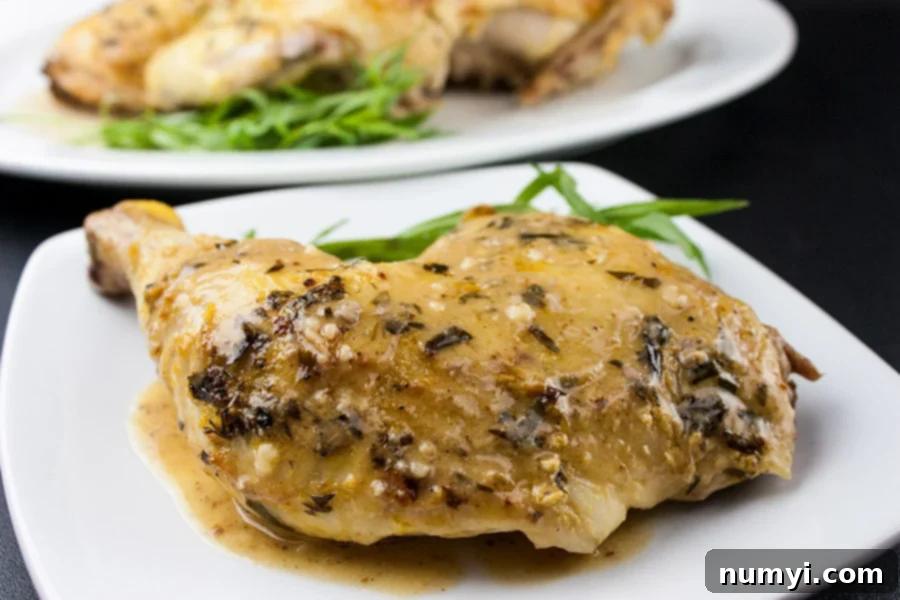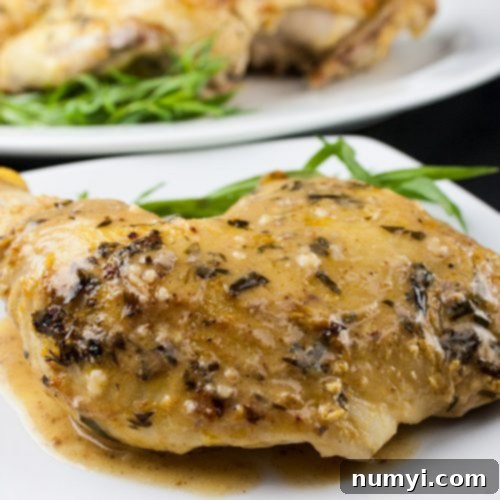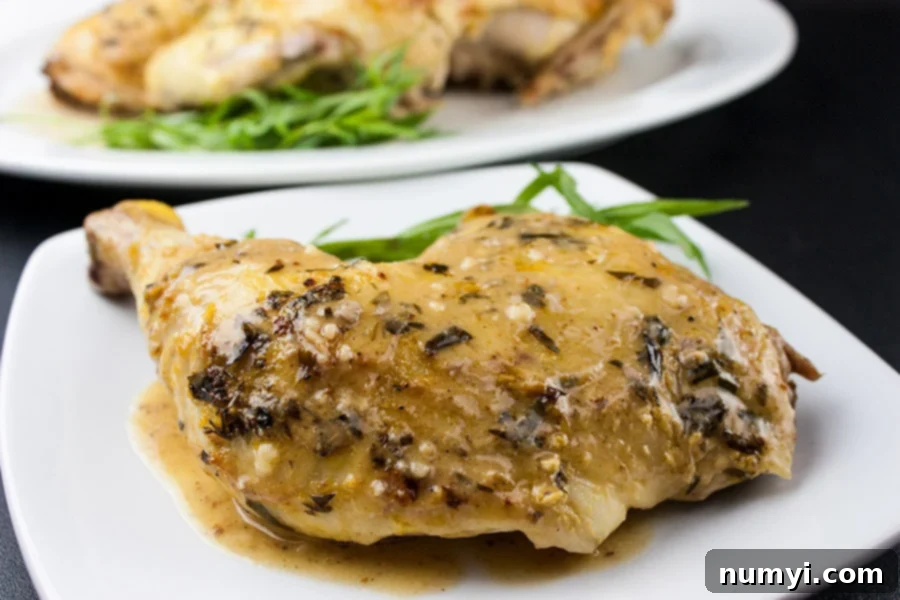Delicious Roasted Chicken with Creamy Dijon Tarragon Sauce (Poulet à la Dijonnaise)
Prepare to tantalize your taste buds with this exquisite Roasted Chicken with Dijon Cream Sauce, a dish so succulent it practically melts in your mouth. This recipe is my cherished rendition of the classic French Poulet à la Dijonnaise, a timeless bistro favorite that transforms simple roasted chicken into an elegant meal with its rich and tangy white wine sauce. Forget complicated culinary techniques; this recipe brings gourmet flavor to your table with straightforward steps, making it perfect for both weeknight dinners and special occasions.

Don’t Sweat The Recipe is supported by its readers. We may earn a commission if you purchase through a link on our site. Learn more.
Why You’ll Adore This Roasted Chicken Recipe
There’s a reason this Roasted Chicken with Dijon Cream Sauce is a perpetual favorite. It’s a harmonious blend of textures and flavors that will impress without demanding hours in the kitchen. Here’s why this recipe deserves a permanent spot in your culinary rotation:
- Unbelievably Tender Chicken: The roasting method, especially if you opt for spatchcocking, ensures every part of the chicken is cooked to perfection – juicy and tender on the inside, with a gloriously golden, crispy skin.
- Exquisite Creamy, Tangy Tarragon Sauce: The star of the show! This luscious sauce, infused with the sharp kick of Dijon mustard and the fresh, aromatic notes of tarragon, envelops the chicken in a velvety richness that’s utterly irresistible. It’s the kind of sauce you’ll want to sop up with every last piece of bread.
- Bistro-Style Elegance at Home: This dish feels like something you’d order at a charming French bistro, yet it’s surprisingly simple to prepare. It strikes the perfect balance between comfort food and sophisticated dining, making it suitable for a casual family meal or an elegant dinner party.
- Effortless Weeknight Meal: Despite its impressive appearance and flavor, this recipe is designed for ease. With about an hour from start to finish, you can enjoy a wholesome, homemade meal even on your busiest evenings.
- Economical and Satisfying: A whole chicken is often an affordable protein option, and this recipe maximizes its flavor potential. It’s a budget-friendly way to feed a crowd or enjoy delicious leftovers.
If you love easy chicken dinners, be sure to also try our one-pan chicken dirty rice, flavorful roasted chicken thighs and vegetables, classic chicken and rice casserole, and the vibrant Spanish chicken and rice for more delicious inspiration.
Essential Ingredients for Your Dijon Chicken
Crafting this incredible dish requires a few key ingredients, each playing a vital role in building the layers of flavor. Quality ingredients make a significant difference, especially with a classic like this.
- Whole Chicken: We recommend a whole chicken weighing approximately 3-5 pounds. While the recipe focuses on a spatchcocked chicken for even cooking and a crispy skin, you can also use bone-in, skin-on chicken pieces like leg quarters, thighs, or breasts for a quicker cook time.
- Flavorful Seasonings:
- Dijon Mustard: This is non-negotiable! The distinctive tangy, slightly spicy flavor of authentic Dijon mustard forms the backbone of our cream sauce and provides a delightful crust on the chicken. Do not substitute with yellow mustard.
- Crème Fraîche: A French-style cultured cream that’s less tart and thicker than sour cream, with a higher fat content that makes it stable for cooking without curdling. It lends a luxurious creaminess to the sauce.
- Fresh Tarragon: This herb is a traditional pairing with Dijon and chicken in French cuisine. Its delicate, anise-like flavor is essential for the authentic taste of the sauce. Fresh is best, but dried tarragon can be used in a pinch (use about 1/3 the amount of fresh).
- Kosher Salt and Black Pepper: Simple, yet crucial for seasoning the chicken thoroughly and balancing the flavors in the sauce.
- Rich Sauce Components:
- Pan Drippings: The flavorful fat and browned bits left in the pan after roasting the chicken are liquid gold! They are the foundation of our sauce, packed with savory chicken flavor.
- All-Purpose Flour: Used as a thickening agent to create a smooth, velvety sauce, forming a roux with the pan drippings.
- Dry White Wine: A splash of dry white wine (like Sauvignon Blanc or Pinot Grigio) deglazes the pan, adding acidity and depth of flavor. Choose a wine you would enjoy drinking, as its flavor will concentrate in the sauce.
- Chicken Stock: Provides the necessary liquid for the sauce, enriching it with further savory notes. Opt for a good quality, low-sodium chicken stock.
Crafting Your Roasted Chicken with Dijon Cream Sauce
This recipe is designed to be approachable, guiding you through each step to achieve a perfectly roasted chicken and a show-stopping sauce. Precision and patience are your best tools here.
Step-by-Step Instructions:
- Preheat Your Oven: Start by preheating your oven to a robust 400°F (200°C). This high temperature helps achieve that desirable crispy skin and ensures the chicken cooks efficiently.
- Prepare the Chicken (Spatchcocking for Success):
While you can roast a whole intact chicken with this sauce, spatchcocking (butterflying) is highly recommended. It significantly speeds up cooking time and ensures the chicken cooks more evenly, resulting in uniformly tender meat and consistently crispy skin. If you’re new to spatchcocking, don’t worry – it’s easier than it sounds:
- Place the whole chicken breast-side down on a sturdy cutting board. Locate the backbone.
- Using heavy-duty kitchen shears, carefully cut along each side of the backbone, from the neck cavity down to the tail. Remove the backbone and discard it (or save it for making chicken stock!).
- Flip the bird over so the breast side is facing up. Now, open the chicken up like a book.
- To flatten it completely, you might need to make a small incision: use a sharp paring knife to cut down the center of the bird, just deep enough to score the cartilage that covers the breastbone. This allows the breastbone to flex. Alternatively, you can simply press down firmly on the breastbone with the heel of your hand until you hear a crack and the chicken lies flat.
- Season and Coat the Chicken:
- Pat the spatchcocked chicken thoroughly dry with paper towels. This crucial step helps achieve a super crispy skin.
- Generously season both sides of the chicken with kosher salt and freshly ground black pepper.
- Place the chicken, skin-side up, in an oven-safe large skillet (cast iron works wonderfully) or a sturdy roasting pan.
- Evenly brush 3 tablespoons of good quality Dijon mustard all over the chicken skin.
- Sprinkle the fresh tarragon evenly over the mustard-coated chicken.
- Finally, spoon the ½ cup of crème fraîche over the entire chicken, ensuring it’s well distributed. This creates a protective, flavorful layer that bastes the chicken as it roasts.
- Roast to Perfection:
Transfer the pan with the prepared chicken to your preheated oven. Roast for approximately 40-60 minutes. The cooking time can vary based on your oven and the size of your chicken. The key indicators for doneness are:
- The thickest part of the breast registers an internal temperature of 150°F (65°C) on an instant-read thermometer.
- The thighs and legs should reach at least 175°F (79°C).
- The skin should be beautifully golden brown and crispy.
- Rest the Chicken: Once cooked, carefully transfer the roasted chicken from the hot pan to a clean cutting board or serving platter. Tent it loosely with foil and let it rest for 10-15 minutes. This resting period is crucial for the juices to redistribute throughout the meat, ensuring a moist and flavorful chicken. Removing it from the hot pan prevents it from overcooking during this time.
- Prepare the Dijon Cream Sauce:
- While the chicken rests, turn your attention to the pan drippings – the foundation of your incredible sauce. Pour off all but about 2 tablespoons of fat from the roasting pan.
- Place the pan over medium-high heat on your stovetop. Add 1 tablespoon of all-purpose flour to the hot fat and whisk vigorously to create a roux. Cook the roux, stirring constantly, for at least 1 minute to cook out the raw flour taste.
- Pour in the ¼ cup of dry white wine. Immediately scrape up any browned bits (known as “fond”) from the bottom of the pan with a wooden spoon or whisk. These bits are packed with concentrated flavor. Allow the wine to simmer for about a minute to cook off the alcohol.
- Stir in 1 cup of chicken stock. Bring the mixture to a boil and let it simmer for 3-4 minutes, whisking occasionally, until the sauce thickens to your desired consistency – a beautiful, creamy gravy.
- Taste the sauce and adjust seasonings with salt and pepper as needed.
- Slice and Serve:
Once the chicken has rested, slice it into individual serving-size pieces. Arrange them artfully on plates and generously drizzle with the warm, luscious Dijon cream sauce. Garnish with a sprig of fresh tarragon for an extra touch of elegance and aroma.
Perfect Pairings: What to Serve with This French-Inspired Chicken
This roasted chicken with creamy Dijon sauce is a complete meal in itself, but it truly shines when accompanied by thoughtful side dishes that complement its rich flavors and creamy texture. Here are some ideal pairings:
- Crusty Bread: Absolutely essential for soaking up every last drop of that amazing sauce! A baguette or artisan loaf is perfect.
- Potatoes:
- Fluffy and smooth Creamy mashed potatoes provide a wonderful canvas for the sauce.
- Hearty Baked potatoes or Loaded cauliflower mash (a lighter alternative) offer comforting textures.
- Rice or Pasta:
- Simple steamed rice is excellent for absorbing the sauce.
- Egg noodles or your favorite pasta (like fettuccine or tagliatelle) can be tossed directly with the chicken and sauce for a satisfying dish.
- Fresh Vegetables:
- A light, simple green salad with a vinaigrette dressing provides a refreshing contrast to the richness of the chicken.
- Steamed or roasted green beans, asparagus, or broccoli offer a vibrant color and healthy crunch.
Expert Tips for the Best Dijon Chicken
Achieving restaurant-quality results at home is easier with a few insider tips:
- Choose Your Chicken Wisely: While a whole spatchcocked chicken offers the best results for even cooking and presentation, feel free to use individual bone-in, skin-on chicken pieces like leg quarters, thighs, or breasts. Just be aware that cooking times will differ. If mixing pieces, use a probe-style thermometer to monitor internal temperatures, as smaller pieces will cook faster.
- Dijon is Key: This cannot be stressed enough – use authentic Dijon mustard. Its distinct tangy, slightly piquant flavor is irreplaceable. Yellow mustard will alter the taste profile significantly and is not recommended.
- Select a Quality White Wine: Choose a dry white wine that you genuinely enjoy drinking, such as Sauvignon Blanc, Pinot Grigio, or an unoaked Chardonnay. The flavor of the wine concentrates in the sauce, so a good quality wine will yield a superior-tasting sauce. Avoid “cooking wines” which often contain added salt and preservatives and lack the nuanced flavor of real wine.
- Alcohol-Free Option: If you prefer to avoid alcohol, you can omit the white wine from the sauce. However, be aware that you will lose a layer of complex flavor and acidity. The good news is that most of the alcohol in wine cooks off during the simmering process, leaving behind only the flavor. Alternatively, some specialty stores offer non-alcoholic cooking wines.
- Experiment with Fresh Herbs: While fresh tarragon is traditional and highly recommended, you can certainly experiment with other fresh herbs. Fresh parsley, thyme, or rosemary can also complement the chicken and Dijon flavors beautifully.
- Achieve the Perfect Sauce Consistency: Don’t rush the sauce. Ensure you let it boil for at least 3-4 minutes after adding the stock to allow it to thicken properly and for the flavors to meld. If it’s too thick, add a splash more chicken stock; if too thin, let it simmer a bit longer.
- Don’t Skip the Resting Time: Resting the chicken after roasting is a critical step. It allows the meat fibers to relax and reabsorb the juices, ensuring a tender, moist, and flavorful result. Cutting into the chicken too soon will cause the juices to run out, leading to dry meat.
- Scrape the Fond: When making the sauce, be sure to vigorously scrape up all the browned bits (fond) from the bottom of the roasting pan when deglazing with wine. These bits are packed with intense flavor and are essential for a rich, deep sauce.
Frequently Asked Questions
Yes, absolutely! You can use bone-in, skin-on chicken breasts, leg quarters, or thighs. Adjust cooking times accordingly, as individual pieces will cook faster than a whole chicken. Always use an instant-read thermometer to ensure they reach safe internal temperatures.
Allow any leftover roasted chicken with Dijon cream sauce to cool completely to room temperature. Transfer it to an airtight container and refrigerate for up to 4 days. Reheat gently on the stovetop or in the oven to prevent drying out the chicken. You might need to add a splash of chicken stock or water to loosen the sauce when reheating.
While crème fraîche is ideal, a good substitute can be full-fat sour cream or heavy cream. If using sour cream, be careful not to boil it vigorously, as it can curdle. Stir it in at the end and heat gently. Heavy cream will give you a rich sauce but will lack the slight tang of crème fraîche.
Easy And Delicious BBQ Chicken Legs Recipe
Slow Cooker Roasted Chicken
Chicken Pot Pie
Are you on Pinterest? Click the button below to add this recipe to one of your boards!

Roasted Chicken with Dijon Cream Sauce Recipe
Print
Pin
Rate
Dinner, Main Course
American, French
15 minutes
50 minutes
1 hour
5 minutes
4
632
kcal
Leigh Harris
Ingredients
For the chicken
-
1
3 – 5 lb
whole chicken
-
1
tsp
kosher salt
-
1/2
tsp
fresh ground pepper
-
3
tbsp
Dijon mustard
-
1 1/2
tbsp
fresh tarragon, chopped
-
1/2
cup
creme fraiche
For the sauce:
-
2
tbsp
pan drippings
-
1
tbsp
flour
-
1/4
cup
white wine
-
1
cup
chicken stock
-
salt and pepper, to taste
Metric
Instructions
-
Preheat oven to 400 degrees.
-
Remove giblets. Place the chicken breast-side down on a cutting board. Use heavy-duty kitchen scissors to cut out the backbone by cutting down from neck to tail along each side. Remove and discard. Open the bird up like a book. Use a sharp paring knife to cut down the center of the bird, just deep enough to incise the cartilage covering the breastbone. Turn the chicken over and press down on the chicken to flatten it completely.1 3 – 5 lb whole chicken
-
Pat the chicken dry with paper towels, season with salt, pepper, and place it in the roasting pan.1 tsp kosher salt,
1/2 tsp fresh ground pepper -
Brush the dijon mustard evenly over the chicken, sprinkle the tarragon over evenly. Then spoon the creme fraiche over the chicken.3 tbsp Dijon mustard,
1 1/2 tbsp fresh tarragon, chopped,
1/2 cup creme fraiche -
Roast for 40-60 minutes, until the thickest part of the breast registers 150°F on an instant-read thermometer and the legs are at least 175°F.
-
Remove the chicken from the pan to a cutting board or plate to rest.
-
Remove all but 2 tablespoons of fat from the roasting pan. Place the pan over medium-high heat and bring to a boil, whisk in 1 tablespoon of flour and cook for at least 1 minute. Add the 1/4 cup of white wine, 1 cup of chicken stock, and boil until it thickens about 3-4 minutes.2 tbsp pan drippings,
1 tbsp flour,
1/4 cup white wine,
1 cup chicken stock,
salt and pepper, to taste -
Slice the chicken into serving size pieces and drizzle with the sauce.
Notes
Storing Leftovers – Let any leftovers cool to room temperature, place them in an air tight container, and refrigerate for up to 4 days.
Nutrition
Calories:
632
kcal
|
Carbohydrates:
6
g
|
Protein:
43
g
|
Fat:
46
g
|
Saturated Fat:
15
g
|
Cholesterol:
185
mg
|
Sodium:
972
mg
|
Potassium:
562
mg
|
Fiber:
1
g
|
Sugar:
2
g
|
Vitamin A:
512
IU
|
Vitamin C:
4
mg
|
Calcium:
70
mg
|
Iron:
3
mg
